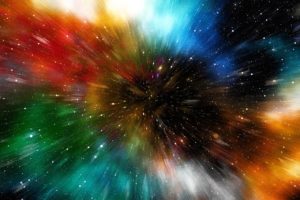
We live in an expanding universe
SURAH ADH-DHARIYAT AYAT 47 (51:47 QURAN)

MUHSIN KHAN Translation: With power did We construct the heaven. Verily, We are Able to extend the vastness of space thereof (Expanding it).
Based on the work of Dr. Caner Taslaman:
The universe in general along with its origins have long been studied topics by man. Is the universe infinite? Or is it finite in a steady state? This had been a debate for centuries amongst scholars and astronomers from multiple ethnic and religious backgrounds. Some of the great minds argued that the universe was not a confined space, while others contended that its boundaries were drawn.
The Quran describes it as a continuously expanding and dynamic universe. According to this description, the universe has a new aspect every instant that deviates from the concept of an infinite space; its perpetual expansion defies the concept of a confined and steady state universe. Thus, the Quran generates a third alternative, leaving the heated controversy of thinkers behind.
This may contribute to the formulation of a judgment for the inquiring minds, probing whether the Quran is God’s revelation or not. We have, on the one hand, Prophet Muhammed (Peace be Upon Him) in the desert, neither a philosopher nor a physicist, and, on the other hand, the assumptions of great thinkers and philosophers such as Aristotle, Ptolemy, Giordano Bruno, Galileo Galilei and Isaac Newton, to name but a few.
The greatest minds in history, basing their arguments on observations and formulas they had ingeniously devised, claimed either that the universe had its confines or that it was an endless space, but it occurred to none of them to think of a dynamic expanding universe.
Until the 20th century when Edwin Hubble, by means of the famed Hubble telescope, demonstrated that the universe was expanding. The theory of expansion of the universe was first advanced in the 1920s. Until the descent of the Quran no other source had made such an assertion!
There was a gap in Newton’s physics. Newton believed in an endlessly vast and static universe. His law of gravity encountered a problem. How was it that the physical bodies, in the course of eons, defied their mutual attractions and did not collapse into a unity? The formula that Einstein devised abandoned the absolute notions of space and time as reference points for all objects in the universe. Basing his studies on Einstein’s formulas, Alexander Friedmann, a Russian physicist, discovered that the universe must be expanding. Georges Lemaître, a Belgian cleric, astronomer and cosmologist, formulated that the universe had begun in a cataclysmic explosion of a small, primeval super atom, like the growing of an oak tree from an acorn.
This theory explained the recession of galaxies within the framework of Albert Einstein’s theory of general relativity. This idea was so incredible that even Einstein had problems accepting it, despite the fact that this all had originated from his own formulas. Einstein, rather, countered that physics was not the forte of Lemaître, and the universe was an infinite expanse and in a steady state.
Lemaître’s theory posited that the universe was expanding. This was a statement that no philosopher and no scientist had ever before set forth. Kant had said in his Critique of Pure Reason that this was an enigma unsolvable by human intelligence. This theory fit everything and explained the reason why the universe did not collapse in spite of gravity. The key had fit into the lock. It was the correct explanation of the enigma. However, this statement met with the usual adverse reaction: “No, it is not the truth…”
Remaining outside the sphere of theoretical controversy, American astronomer Hubble was, about the same time, making observations with his sophisticated telescope in the Mount Wilson observatory. He observed that galaxies were receding from each other, which proved that the universe was expanding. In answer to those who said they could not believe in things their eyes had not witnessed, Hubble’s discovery led to the following declaration: “Now that you see it, you have got to believe it.” Hubble showed this by the Doppler Effect. Thus the wavelengths of receding bodies prolonged in the spectrum of light waves would shift to red, while, if the bodies approached each other, the wavelengths would shorten, shifting to blue. The light that came from galaxies that shifted to red and showed that the galaxies were receding.
In line with this observation, Hubble discovered a striking law: the speed of galaxies that receded was directly proportional to the distance between galaxies. The farther away a galaxy stood, the more its speed of recession accelerated. The result was tested again and again. In 1950, a high-magnification telescope was installed on Mount Palomar in the USA, the largest instrument of its kind. The new tests and controls justified this observation. The measurements made pointed to the fact that the creation of the universe occurred about 10-15 billion years ago.
Both Einstein and Lemaître took an interest in Hubble’s work; Einstein, who did not agree with Lemaître at first, eventually acknowledged during a conference that Lemaître was right after all. He confessed that his failure to endorse these findings had been the gravest error in his life. Thus it was that the fact that the universe was of a dynamic nature and expanding, confirmed by observations, was also validated by the great physicist Einstein.
In the examples presented by Hubble and Lemaître, we see illustrated how a physicist arrives at a conclusion both in theory and through observation. While Lemaître demonstrated how he had made inferences from Einstein’s formulas to substantiate his theoretical discoveries, Hubble presented the data of his observations and his conclusions. As we see, the result obtained by physicists is the consequence of cumulative and collective bits of knowledge and research.
The Creator of physical laws provides the answer in the Quran to the issues of towering importance throughout human history. The Quran’s presentation of scientific facts is clear, direct, and concise; it is different than the presentation of scientists, which tends to be complicated by scientific methods and procedures. The provider of this answer does not have to go through all the labyrinths a scientist has to. The Quran’s method is perfectly straightforward, unswerving and explicit.
If we had the possibility of looking at the universe from above and somebody asked us to describe what we saw, our answer would be that it was expanding. To achieve the Quran’s revelation of this fact 1400 years ago, man would have needed access to the assistance of accumulated scientific data acquired throughout long years and to sophisticated telescopes.
When people claim that science and religion oppose each other, the Quran furnishes answers to the most complicated scientific problems. Observations made by sophisticated telescopes today confirm the statements of the Quran. The Quran, perfectly aware of the human psyche with its prescience, states that nonbelievers will insist on their convictions regardless how many miracles are presented to them. Some ask:
“Why did the people also not believe in Jesus, who had performed miracles and healed the sick and the blind?” This example demonstrates why the majority of people did not believe in Christ and the other prophets, despite their miracles. Miracles change in fact as time goes by, but the negative attitude of most humans remains unchanged.
